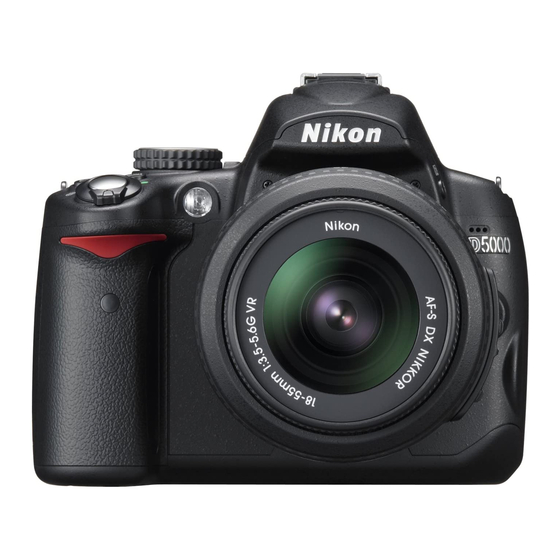Nikon D5000 Handmatig - Pagina 28
Blader online of download pdf Handmatig voor {categorie_naam} Nikon D5000. Nikon D5000 32 pagina's. Nikon digital slr camera product brochure
Ook voor Nikon D5000: Brochure (9 pagina's), Spiekbriefje (2 pagina's), Reparatiehandleiding (20 pagina's)

WHITE BALANCE AND THE TEMPERATURE OF COLOR
When you select different white balances in your camera, you will notice that underneath
several of the choices is a number, e.g., 5200K, 7000K, or 3200K. These numbers refer
to the Kelvin temperature of the colors in the visible spectrum. The visible spectrum is
the range of light that the human eye can see (think of a rainbow or the color bands that
come out of a spectrum). The visible spectrum of light has been placed into a scale called
the Kelvin temperature scale, which identifi es the thermodynamic temperature of a given
color of light. Put simply, reds and yellows are "warm" and greens and blues are "cool."
Even more confusing can be the actual temperature ratings. Warm temperatures are typi-
cally lower on the Kelvin scale, ranging from 3000 degrees to 5000 degrees, while cool
temperatures run from 5500 degrees to around 10000 degrees. Take a look at this list for
an example of Kelvin temperature properties.
KELVIN TEMPERATURE PROPERTIES
Flames
Incandescent bulb
White fl uorescent
Moonlight
The most important thing to remember here is how the color temperature of light will
affect the look of your images. If something is "warm," it will look reddish-yellow, and if
something is "cool," it will have a bluish cast.
7. SET YOUR COLOR SPACE
The color space deals with how your images will ultimately be used. It is basically a
set of instructions that tells your camera how to defi ne the colors in your image and
then output them to the device of your choice, be it your monitor or a printer. Your
camera has a choice of two color spaces: sRGB and Adobe RGB.
The fi rst choice, sRGB, was developed by Hewlett-Packard and Microsoft as a way
of defi ning colors for the Internet. This space was created to deal with the way that
computer monitors actually display images using red, green, and blue (RGB) colors.
1700K–1900K
2800K–3300K
4000K
4000K
Daylight
5000K
Camera fl ash
5500K
Overcast sky
6000K
Open shade
7000K
C H A P T E R 1 : T H E D 5 0 0 0 T O P T E N L I S T
15
